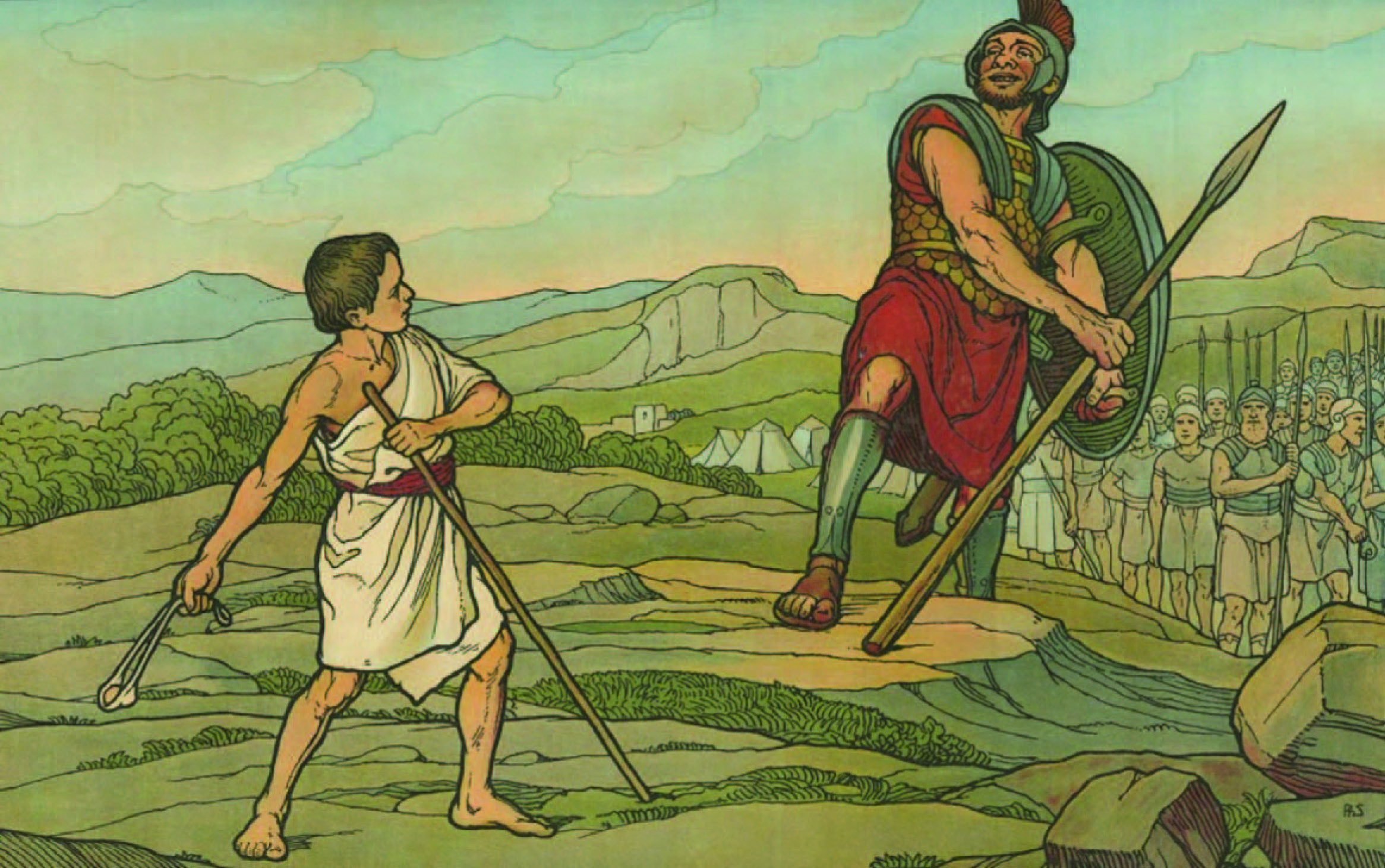History’s greatest ‘best-case’ scenarios.
Roughly 3,000 years ago, the Israelites and Philistines faced off in the Valley of Elah for what promised to be a costly, no-win bloodbath. The two sides did the sensible thing and agreed to settle their differences in single combat, but the Hebrew warrior-king Saul was none too keen on tangling with the giant Goliath. People were measured in cubits back then and Goliath had cubits to spare; most Biblical scholars believe that he stood nearly seven feet tall, so Saul’s reluctance is understandable. You know the rest of the story: A boy named David, tasked with bringing food to his older brothers on the front lines, volunteered to take on the towering Philistine by himself. He selected five smooth stones from a riverbank, eschewed Saul’s offer of armor and spear in favor of his trusty sling and—after some Old Testament trash-talking—took out Goliath with a rock to the forehead…and then decapitated his corpse (because that’s how they rolled back then) as the defeated Philistines hustled back to wherever it was they came from.
As “best-case scenarios” go, this one is arguably the great-grand-daddy of them all, especially considering the worst-case alternative: the near certainty that David would end up squirming in agony on the business end of Goliath’s javelin, his head soon to be a hood ornament on the giant’s chariot. Over the 30-plus centuries since, we have used this Biblical encounter to characterize the most extreme mismatches or impossible odds. When you say “David versus Goliath” everyone knows exactly what you mean. For what it’s worth, the same Biblical scholars who worked out Goliath’s height have also suggested that David might not have been the stone-slinging hero that day. Elhanen may have taken out Goliath; or perhaps David and Elhanen were one in the same. Regardless, it is David whose name we remember. It’s a testament to good press, no pun intended.
What makes an iconic, all-time great best-case scenario? You begin with a bleak set of circumstances, brought on by bad luck, poor decisions or misplaced courage. Then you need to consider the horrible (and highly likely) worst-case scenario. Finally, there has to be a magnificent, wow-factor plot twist—one that almost no one saw coming—that transforms a worst case into a best one. Given those ground rules, these are some of my favorites…
Squeeze Play
Battle of Salamis • 480 BC
The Persian Empire, under King Xerxes, invades Greece—then a loose confederation of city-states—and crushes Greek land forces in battle after battle. Athenian general Themosticles hatches a plan to lure the Persian fleet of 1,200 warships into a decisive battle against 180 Athenian vessels in the narrow strait of Salamis.
Worst Case Scenario: Persia destroys the Greek fleet, picks off the remaining city-states and snuffs out Western civilization before it begins.
How It Went Down: The Persian vessels press for a decisive victory, but their lines become jumbled as the battlefield narrowed, just as Themosticles had planned. The Greek ships form a wedge and ram their way through the disorganized Persian navy, sending heavily armored marines streaming onto enemy boats against the lightly armored Persian fighters. Xerxes may have lost half or more of his fleet in the debacle and Greece was never threatened by Persia again.
Runaway Success
The American Revolution • 1775
British colonists, unhappy with their lack of say in Parliament, decide to take on the most powerful global military force in history for an idea: Freedom.
Worst Case Scenario: The Redcoats send their best troops to America, crush the ill-equipped and poorly trained colonial rebels, hang the signers of the Declaration of Independence, and then return to business as usual.
How It Went Down: Fighting an “idea” turns out to be a losing battle, at least in this case. The Americans know they had home-field advantage: They didn’t have to beat the British, only wear them out. With help from France, Washington’s army traps Cornwallis and his army at Yorktown and the rest is history. P.S. England saw New Jersey as a convenient highway between Philadelphia and New York City. How wrong they were!
Thigh Master
Harland Sanders 1930
An impulsive, self-righteous and occasionally violent 40-year-old ex-manual laborer and disgraced attorney is hired to run a Shell station in Depression-era Kentucky. He begins selling fried chicken out of the structure to make ends meet.
Worst Case Scenario: Sanders blows yet another employment opportunity or, worse, kills an unwary traveler with tainted chicken.
How It Went Down: Thanks to his “secret recipe” and pressure-cooking method, Sanders turns Kentucky Fried Chicken into one of the great franchise operations in the world during the 1950s and 1960s. Sanders sells to John Y. Brown for $2 million in 1964 and becomes KFC’s brand ambassador.
Hat’s Off
Harry Truman 1945
A former haberdasher and Kansas City ward healer chosen by President Franklin Roosevelt as his 1944 running mate, the lowly regarded and largely marginalized Truman ascends to the oval office after FDR’s death. Truman has never been told about the atomic bomb, believes that Russia and China might make good postwar allies, and has a habit of personally attacking anyone he feels has slighted him.
Worst Case Scenario: Truman’s inexperience, stubbornness and indecisive leadership prolongs the war in the Pacific, leaves Europe in ruins and chokes off the American economy, leading to a humiliating defeat in the 1948 presidential election.
How It Went Down: Truman brings the war to a rapid conclusion, resurrects Europe with the Marshall Plan, keeps Greece and Turkey out of Communist hands, orchestrates the Berlin Airlift, supports the formation of NATO and the United Nations, pioneers legislation that creates the FHA and ends segregation in the armed forces. And still almost loses the 1948 election!
Roll Up Your Sleeves, Boys
Polio Vaccine 1953
While still in testing phase, Dr. Jonas Salk brings home samples of his polio vaccine and inoculates his three young sons. Prior to this, Salk had mostly administered the vaccine to monkeys.
Worst Case Scenario: His sons turn into monkeys. No, just kidding. A life-threatening adverse reaction and the bad publicity accompanying it set back the polio program for years.
How It Went Down: The Salk children experience no ill effects and America welcomes the news with unrestrained joy. “There was jubilation,” Peter Salk recalls. “There was such a sense of relief that this fear, which had been hanging over everyone’s heads for years and years and years, was finally lifted.”
Top Cop
Lasse Viren • 1972
A police officer makes Finland’s Olympic team and reaches the finals of the 10,000 meters at the Summer Games in Munich.
Worst Case Scenario: He literally falls flat on his face. Which he did, midway through the race.
How It Went Down: Viren gets to his feet, catches up with the pack and stuns the crowd by starting his “kick” with more than a lap to go, winning gold in world-record time. In the 5,000 meters a week later, Viren wins again, beating heralded American Steve Prefontaine and other top international stars.
Vision Quest
Botulinum Toxin 1977
Ophthalmologist Dr. Alan Scott begins injecting botulinum type A neurotoxin into patients to treat strabismus, a condition that causes eyes to cross or diverge.
Worst Case Scenario: The neurotoxic protein is considered nature’s most poisonous substance; so blindness, paralysis and death.
How It Went Down: The experiments are an unqualified success and during the 1980s, Dr. Scott trains hundreds of ophthalmologists how to inject the drug he names Oculinum. In 1991, he sells Oculinum for $9 million to the drug company Allergan, which renames it Botox. In 2002, Botox is approved by the FDA for cosmetic use.
Emerging from the Rubble
The McRib • 1981
Following a promising test-marketing run, the McRib sandwich becomes a regular menu item at McDonald’s…and is a disastrous failure. It is removed from U.S. stores in 1985, then returns on a “limited” basis nine years later as a tie-in to The Flintstones live-action movie, with packaging that features Rosie O’Donnell as Betty Rubble.
Worst Case Scenario: The gray, “restructured” pork slab is a critical flop in its second incarnation, much as The Flintstones was.
How It Went Down: Over the next two decades, McDonald’s offers the McRib through special limited-time promotions before announcing a “Farewell Tour” for the sandwich in 2005. A grassroots consumer effort to save the McRib creates a groundswell of demand, which is further accelerated by social media posts that help fans “chase” the McRib wherever it is being offered. In 2020, during the COVID-19 pandemic, McDonald’s makes the McRib available nationwide for the first time.
Can Do
Pabst Blue Ribbon • 1996
A beer brand in business for more than 150 years shutters its flagship brewery in Milwaukee following two decades of declining revenue. Five years later, the company hires a former Benetton exec to turn the company around.
Worst Case Scenario: Marketing a beer brand that has lost 90% of its customers proves a bit more difficult than selling sweaters…and “PBR” joins Jax, Falstaff, Schmidt’s, Grain Belt and Narragansett in the pantheon of extinct and zombie beer brands.
How It Went Down: One word: Hipsters. Pabst finds a new fan base with urban 20-somethings in search of the next dive bar and an ironic down-market beer. The company pours marketing dollars into sponsorships of indie rock, cool small businesses, post-college sports leagues and social media…and the brand returns to market prominence.
Sticking With It
The Blair Witch Project • 1999
Wannabe film makers Daniel Myrick and Eduardo Sanchez write an improvised script about a trio of hikers who disappear in the Maryland woods. They blow through their $25,000 budget in eight days and shoot 20 hours of action to create a grainy 82-minute film they hope will go straight to cable.
Worst Case Scenario: A sci-fi film with no witch and no special effects is of little interest to distributors, no network will air it, critics pan it, audiences hate it, Myrick and Sanchez are broke and never find work in the movie industry again.
How It Went Down: Blair Witch generates buzz at the 1999 Sundance Festival by listing its actors as missing or dead and is marketed to filmgoers almost exclusively through the Internet, receiving more than 150 million hits. It grosses $250 million, returning ten thousand times its original cost and pioneering the genre of found-footage film making.
Crab Fest
Deadliest Catch • 2005
Ex-Turner Broadcasting honcho Thom Beers films a pair of one-hour documentaries about crab fishing in Alaskan waters during the 1990s and successfully shops the concept as a cable-TV reality series.
Worst Case Scenario: Audiences quickly lose interest in a show hinging on how many crustaceans tumble out of a wire trap…episode after episode after episode.
How It Went Down: The gritty, true-to-life documentary style of the show—backed by the narration of Dirty Jobs star Mike Rowe—transfixes audiences, who learn that commercial fishing is not only wildly unpredictable…it does indeed have the highest mortality rate of any profession in the world. Deadliest Catch aired its 250th episode in 2020 and is still going strong.









